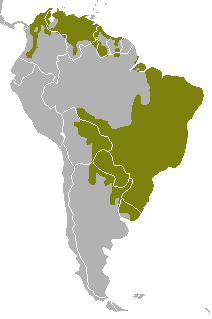| Crab-eating fox[1] | |
|---|---|

| |
| Cerdocyon thous from Colombia | |
| Scientific classification | |
| Domain: | Eukaryota |
| Kingdom: | Animalia |
| Phylum: | Chordata |
| Class: | Mammalia |
| Order: | Carnivora |
| Family: | Canidae |
| Tribe: | Canini |
| Subtribe: | Cerdocyonina |
| Genus: | Cerdocyon C. E. H. Smith, 1839 |
| Species: | C. thous
|
| Binomial name | |
| Cerdocyon thous (Linnaeus, 1766)
| |

| |
| Crab-eating fox range | |
| Synonyms | |
|
Canis thous Linnaeus, 1766 | |
The crab-eating fox (Cerdocyon thous), also known as the forest fox, wood fox, bushdog (not to be confused with the bush dog) or maikong, is an extant species of medium-sized canid endemic to the central part of South America since at least the Pleistocene epoch.[1][2][4] Like South American foxes, which are in the genus Lycalopex, it is not closely related to true foxes. Cerdocyon comes from the Greek words kerdo (meaning fox) and kyon (dog) referring to the dog- and fox-like characteristics of this animal.[5]
- ^ a b Wozencraft, W. C. (2005). "Order Carnivora". In Wilson, D. E.; Reeder, D. M. (eds.). Mammal Species of the World: A Taxonomic and Geographic Reference (3rd ed.). Johns Hopkins University Press. p. 578. ISBN 978-0-8018-8221-0. OCLC 62265494.
- ^ a b Lucherini, M. (2015). "Cerdocyon thous". IUCN Red List of Threatened Species. 2015: e.T4248A81266293. doi:10.2305/IUCN.UK.2015-4.RLTS.T4248A81266293.en. Retrieved 13 November 2021.
- ^ "Appendices | CITES". cites.org. Retrieved 2022-01-14.
- ^ Cite error: The named reference
:2was invoked but never defined (see the help page). - ^ Braun, Janet K.; Mares, Michael A. (1995). "The Mammals of Argentina: An Etymology" (PDF). Mastozoología Neotropical. 2 (2). SAREM: 173–206. ISSN 0327-9383. Archived from the original (PDF) on October 18, 2016.
